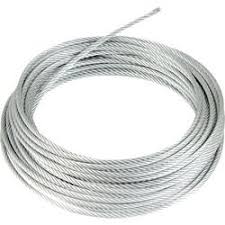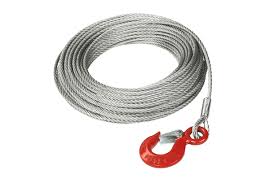1. Introduction
Steel wire ropes are essential components in lifting operations across various industries, including construction, shipping, and manufacturing. Selecting the appropriate wire rope ensures safety, efficiency, and longevity of equipment. High-quality wire ropes offer superior strength, flexibility, and resistance to environmental factors, making them indispensable for heavy-duty applications.

2. What is a Steel Wire Rope?
A steel wire rope consists of multiple strands of steel wires twisted together to form a robust and flexible structure. The primary components include:
- Wires: Individual steel filaments that provide strength.
- Strands: Groups of wires twisted together.
- Core: The central component around which strands are laid.
Common core types:
- Fiber Core (FC): Offers flexibility but less strength.
- Independent Wire Rope Core (IWRC): Provides higher strength and resistance to crushing.certex-uk+2Union Rope+2Energy.gov+2
For lifting applications, IWRC is generally preferred due to its superior load-bearing capacity.

3. Key Factors in Choosing the Best Steel Wire Rope for Lifting Equipment
When selecting a steel wire rope for lifting purposes, consider the following factors:
- Load Capacity / Working Load Limit (WLL): Ensure the rope can handle the maximum load, incorporating a safety factor.
- Tensile Strength and Flexibility: High tensile strength ensures durability, while flexibility allows for ease of handling.
- Rope Diameter and Length: Match the rope size to the equipment specifications and lifting requirements.
- Construction Type: Common constructions like 6×19 or 6×37 offer different balances between strength and flexibility.
- Fatigue and Abrasion Resistance: Choose ropes with coatings or materials that resist wear and environmental degradation.

4. Types of Steel Wire Ropes Used for Lifting
Different types of steel wire ropes cater to specific lifting needs:
- Galvanized vs. Ungalvanized: Galvanized ropes have a zinc coating for corrosion resistance, ideal for outdoor or marine environments.
- Anti-Twisting Wire Ropes: Designed to prevent rotation under load, crucial for precise lifting operations.
- Rotation-Resistant Ropes: Constructed to minimize spinning, enhancing safety during lifts.
- Coated Wire Ropes: PVC or nylon coatings provide additional protection against abrasion and environmental factors.Kebles Trading

5. Applications: Where and How Steel Wire Rope is Used in Lifting
Steel wire ropes are utilized in various lifting scenarios:
- Cranes: For hoisting heavy materials on construction sites.
- Hoists: In manufacturing plants for moving equipment or products.
- Winches: Used in towing and recovery operations.
- Construction Equipment: Essential for scaffolding and structural lifts.
- Elevators and Marine Applications: Provide reliable vertical movement and withstand harsh marine conditions.Energy.gov+1LOADMATE+1Bishop Lifting
6. Safety and Maintenance Tips
Proper maintenance ensures the longevity and safety of steel wire ropes:
- Regular Inspections: Check for signs of wear, corrosion, or damage before each use.
- Signs of Wear: Look for broken wires, kinks, or flattening.
- Lubrication: Apply appropriate lubricants to reduce friction and prevent corrosion.
- Storage Guidelines: Store in a dry, cool place, away from chemicals and moisture.
7. Top Steel Wire Rope Brands & What to Look For in a Supplier
When sourcing steel wire ropes, consider the following:
- Quality Assurance: Ensure the supplier provides certified products meeting industry standards.
- Product Range: A wide selection indicates the supplier can meet diverse needs.
- Customer Support: Responsive service is crucial for addressing queries and issues.
At US Enterprises Tools, we offer a comprehensive range of high-quality steel wire ropes suitable for various lifting applications.
8. FAQs on Steel Wire Rope for Lifting
Q1: What is the lifespan of a lifting wire rope?
A: Lifespan varies based on usage and maintenance but typically ranges from 1 to 5 years.
Q2: How often should I inspect the rope?
A: Conduct visual inspections before each use and comprehensive checks monthly.
Q3: Can I use the same rope for different lifting equipment?
A: It’s advisable to use ropes specific to each equipment type to ensure safety and compliance.
9. Conclusion
Choosing the best steel wire rope for lifting equipment is critical for operational safety and efficiency. By understanding the types, applications, and maintenance practices, you can make informed decisions.
Explore high-quality lifting wire ropes at US Enterprises Tools.
